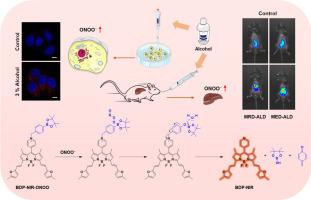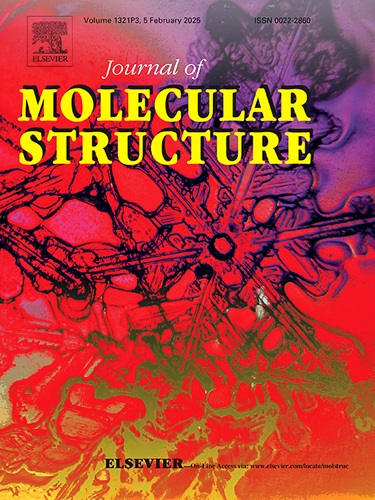A near-infrared ONOO−-activated fluorescent probe for real-time visualizing of alcoholic liver disease
IF 4
2区 化学
Q2 CHEMISTRY, PHYSICAL
引用次数: 0
Abstract
Alcoholic liver disease (ALD) is a liver disease which caused by excessive drinking. It is deeply associated with liver inflammation and brings about up-regulation of reactive oxygen species including peroxynitrite (ONOO−). In this work, we developed a near-infrared (NIR) ONOO−-activated fluorescent probe BDP-NIR-ONOO for real-time visualizing of alcoholic liver disease. BDP-NIR-ONOO showed excellent response to ONOO− in vitro tests, with NIR emitting wavelength (700 nm), good specificity, fast response speed (80 s), and high signal to noise ratio (252-fold). BDP-NIR-ONOO could detect the up-regulation of ONOO− content in the mouse peritonitis model and realize the diagnosis of inflammation in mice. Meanwhile, BDP-NIR-ONOO could image endogenous ONOO− in mice tumor. Most importantly, one mimic risky drinking ALD mice models and one mimic excessive drinking ALD mice models were established, BDP-NIR-ONOO could visualize the alcoholic liver injury of mice by imaging the ONOO− fluctuation in ALD mice, which providing a powerful tool for the diagnosis of ALD. Finally, BDP-NIR-ONOO was further utilized to dynamically trace the therapeutic effect of N-acetylcysteine on ALD.

用于实时观察酒精性肝病的近红外 ONOO 激活型荧光探针
酒精性肝病(ALD)是一种由过度饮酒引起的肝病。它与肝脏炎症密切相关,并导致包括过氧化亚硝酸盐(ONOO-)在内的活性氧上调。在这项工作中,我们开发了一种近红外(NIR)ONOO-激活荧光探针 BDP-NIR-ONOO,用于实时观察酒精性肝病。BDP-NIR-ONOO对体外测试中的ONOO-反应极佳,其近红外发射波长(700 nm)、特异性好、反应速度快(80 s)、信噪比高(252倍)。BDP-NIR-ONOO 可检测小鼠腹膜炎模型中 ONOO- 含量的上调,实现对小鼠炎症的诊断。同时,BDP-NIR-ONOO 还能对小鼠肿瘤中的内源性 ONOO- 进行成像。最重要的是,BDP-NIR-ONOO 建立了一个模拟危险饮酒 ALD 小鼠模型和一个模拟过量饮酒 ALD 小鼠模型,通过对 ALD 小鼠体内 ONOO- 波动的成像,可观察到小鼠酒精性肝损伤的情况,为 ALD 的诊断提供了有力的工具。最后,BDP-NIR-ONOO 被进一步用于动态追踪 N-乙酰半胱氨酸对 ALD 的治疗效果。
本文章由计算机程序翻译,如有差异,请以英文原文为准。
求助全文
约1分钟内获得全文
求助全文
来源期刊

Journal of Molecular Structure
化学-物理化学
CiteScore
7.10
自引率
15.80%
发文量
2384
审稿时长
45 days
期刊介绍:
The Journal of Molecular Structure is dedicated to the publication of full-length articles and review papers, providing important new structural information on all types of chemical species including:
• Stable and unstable molecules in all types of environments (vapour, molecular beam, liquid, solution, liquid crystal, solid state, matrix-isolated, surface-absorbed etc.)
• Chemical intermediates
• Molecules in excited states
• Biological molecules
• Polymers.
The methods used may include any combination of spectroscopic and non-spectroscopic techniques, for example:
• Infrared spectroscopy (mid, far, near)
• Raman spectroscopy and non-linear Raman methods (CARS, etc.)
• Electronic absorption spectroscopy
• Optical rotatory dispersion and circular dichroism
• Fluorescence and phosphorescence techniques
• Electron spectroscopies (PES, XPS), EXAFS, etc.
• Microwave spectroscopy
• Electron diffraction
• NMR and ESR spectroscopies
• Mössbauer spectroscopy
• X-ray crystallography
• Charge Density Analyses
• Computational Studies (supplementing experimental methods)
We encourage publications combining theoretical and experimental approaches. The structural insights gained by the studies should be correlated with the properties, activity and/ or reactivity of the molecule under investigation and the relevance of this molecule and its implications should be discussed.
 求助内容:
求助内容: 应助结果提醒方式:
应助结果提醒方式:


